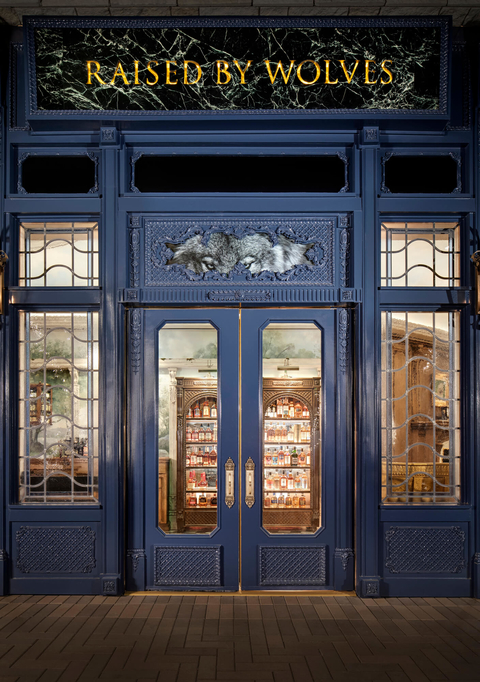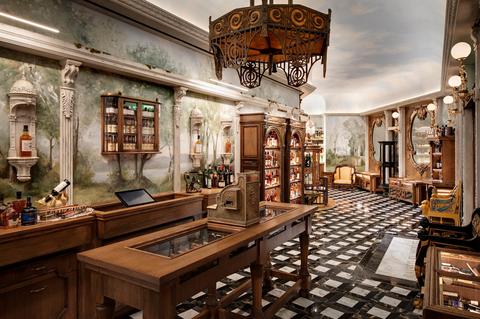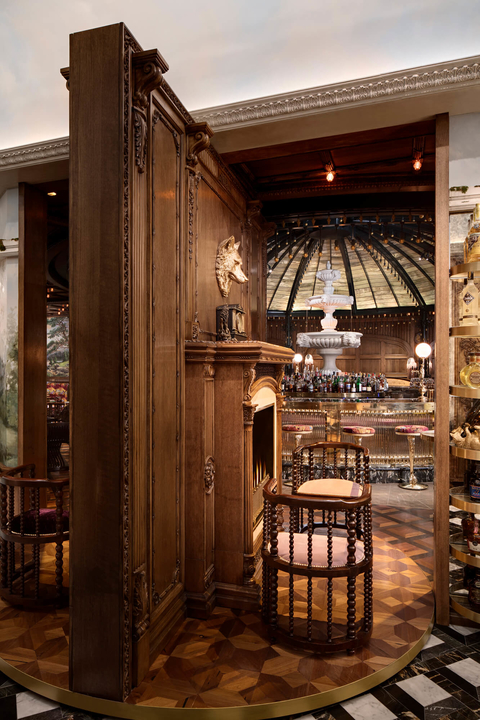Would you open a cocktail bar in a mall? That idea may seem ridiculous to you. But what if I told you that entrepreneur, bartender, bar business icon and industry podcaster Erick Castro thought it was a great idea?
Castro, Arsalun Tafazoli and Consortium Holdings opened a high-end speakeasy, cocktail bar and bottle shop in a mall in La Jolla earlier this year. Called Raised by Wolves, the bar and shop is winning over guests and critics, and it’s smack-dab in the middle of the Westfield UTC mall.
“A lot of people thought we were crazy to open a bar at the mall but if anything, I would say opening a bar in the mall was one of the smartest things we could do, in retrospect,” explains Castro. “They’ve invested so much money in that mall. There was over five hundred million dollars worth of investment in it last year, and six hundred and fifty [million] this year. They’re building condos on mall property, so it’s a really high-end mall.”
You won’t find standard shops inside Westfield UTC. There’s no Foot Locker, there’s no Charlotte Rouse, as Castro points out. Instead, visitors go for places like SoulCycle, an Apple store, and John Varvatos. The dining options also drew in Castro and his partners.
“No one here is doing serious cocktails, so we don’t need to offer food. We can come in, we’ll open right in the middle of all the restaurants, and then we’ll pick up people who are getting off work, people on their way to dinner, people getting off dinner… There’s a movie theater in there, we’ll just catch everybody out for dates,” says Castro of their approach to opening in an unexpected location.
The story of how Raised by Wolves came to be is part of a larger conversation Castro and I had about conceptualizing a bar or restaurant, choosing a location, and building it out. During our conversation he identified a few pitfalls operators opening new venues should avoid. One of the first we discussed is operators not truly knowing their concept or what they want to achieve.
“It’s actually very similar in regards to the pop-up. You have to know what you’re trying to achieve and then just commit to it 100 percent,” says Castro. “You have to have a solid identity of what concept you’re trying to create as well, which is huge because I feel like a lot of people don’t really know. So, they’ll open up their bar with the mindset of, ‘Oh, yeah, so, it’s gonna be fine dining and also like a nightclub.’ They don’t know. They’re trying to appeal to too many people.”
Read this: Planning and Executing a Profitable Pop-Up
However, realizing a concept in its entirety involves more than sitting down and detailing the type of bar it will be; the design aesthetic and desired atmosphere; layout and equipment; menu programming; and buildout plans. It starts, Castro advises, with scouting location.
“You have to look at the neighborhood first. I try to find an underserved market in the neighborhood,” suggests Castro. “So, you’ll look at the neighborhood and you can tell what [it’s] missing. If you see five craft cocktail bars in one small neighborhood and none of them are super busy, that might not be the neighborhood for craft cocktails. If they’re all crankin’ busy, then you obviously have the market for it.”

In his opinion—and it’s an opinion guided by several years of experience working behind, conceptualizing and opening bars—it’s all well and good to know what kind of bar you want to open. But if your vision and the reality of the neighborhood don’t match up you may be setting yourself up for an unnecessary struggle. Or worse yet, failure.
Visit the neighborhood in which you want to open your bar or restaurant at different times of the day and night. Of course, you’ll want to see what’s going on and who’s out and about during your planned business hours. But also visit during the off hours—you may find you need to make adjustments to your hours of business. Ask yourself the important questions:
- Do my planned hours work for this neighborhood?
- Are the people who are going out to restaurants and bars in this neighborhood my target demographic?
- Does my concept fit within this neighborhood?
- Does my concept serve an underserved market?
- Am I up against stiff competition?
- What's the competition doing that I can do better?
- What need is the competition not providing that I can provide?
- Is there an established bar and/or dining scene here?
- What kind of bars and restaurants are operating here?
Opening a business in a particular neighborhood makes it your neighborhood even if you don’t live there. You’re serving the people of that community—does it work for you, and will it work for them?
Read this: The Perfect Concept: 5 Key Design Steps
“I would say, look in a neighborhood and say, ‘Okay, cool—there’s a lot of really nice restaurants here, the dining scene goes really late, and there’s just tons of places to eat. What would crush it here is a cocktail bar with no food,’” advises Castro. “Just a place where the emphasis [is] all cocktails so people can come here before and after dinner and you don’t have to worry about paying a kitchen or stocking a kitchen or paying cooks or anything like that because the idea is that since there’s already so many busy restaurants around you they’re gonna keep your bar full.”
And if the neighborhood is chock-full of high-design, high-concept bars?
“If a place has a bunch of really high-end bars… They’re all kinda stuffy, nice places, maybe a sports bar would kill right there,” suggests Castro. “You wanna take a look at the demographics. I’m not gonna try to open a bar that caters to families any time soon but if I was doing it in a neighborhood that had tons of young families and they were still young enough that they were going out, and their kids are under 8 years old, I would consider doing a more family-friendly bar in a neighborhood like that. But I wouldn’t recommend doing that in, say, the East Village because that’s not what they want.”
So, what convinced Castro and Consortium Holdings that Westfield UTC, a shopping mall, was the right place for a speakeasy and bottle shop called Raised by Wolves? Several factors played roles in the decision, and target market was one of them.
“You want a place where…there’s a bunch of people in that neighborhood who want to spend money on a certain product but nobody else is offering it,” says Castro, and Westfield UTC fits that bill.
As you may be aware, several cities around the United States are attempting to figure out how to repurpose malls. Online shopping has reduced traffic at brick-and-mortar stores, and the concept of the shopping mall has, to a point, become antiquated.
Malls are built on large swaths of land, much of which is surface and subterranean parking space. Recently, several enterprising developers and city planners have developed plans to save the idea of the mall—and solve the problem of how to more efficiently use the space they take up.
Malls are being re-imagined so that their decades-old designs can be transformed into live-work-play communities. When Castro and his partners learned how much money was being pumped into Westfield UTC and how it was being allocated, they saw the opportunity to bring Raised by Wolves to life. They were also patient.
“We’ve been playing with that idea for years. I mean, Polite Provisions was actually supposed to be the place that had a bottle shop and a bar,” says Castro, explaining that Raised by Wolves was first conceptualized in 2015 but due to several issues the concept didn’t work out right away.

So, Castro and Consortium Holdings exercised patience. This allowed them to give Raised by Wolves its best chance at survival. That restraint eventually trickled into the design and buildout process. Nothing looks rushed, no detail appears to have been missed. The right location in the right neighborhood was selected, as was the right designer. Due in no small part to waiting to do things the best way, Raised by Wolves was built out correctly without wasting valuable resources.
“Make sure you have a firm concept before you ever start building anything out,” cautions Castro.
Beginning a buildout when the idea hasn’t been fully fleshed out can mean burning resources—including tons of money—before the project should have even started. Nobody should begin construction before they know “what the space means,” says Castro. Anyone who has gone through the process of construction on a bar, nightclub or restaurant knows what a huge drain such a mistake can be.
“I actually saw a space recently that they probably dumped two million dollars into the place before they even realized they wanted to make it a speakeasy,” says Castro of this type of error. “You end up having to reverse engineer to fit the space you commit to and that can cost thousands upon thousands of dollars. I mean, it probably wasn’t two million but I’m guessing they probably did over one.” Either way, a very expensive and hard lesson to learn.
As far as the design of Raised by Wolves, Castro says that business partner Tafazoli, co-founder of Consortium Holdings, the group behind Polite Provisions, Craft & Commerce, Noble Experiment and other successful bars, partnered with Paul Basile and BASILE Studio to bring the concept to life.
“It was very collaborative, with everybody having a little bit of input. But I would say the two of them are more of the driving force,” says Castro of Tafazoli and Basile’s approach to designing the La Jolla bar and bottle shop.

The lesson here is simple: Play to your strengths and the strengths of your business partners. There’s no shame in letting a partner who can communicate with a designer take over that part of the project. Be honest with yourself and with your partners about your strengths, weaknesses, interests as an owner and operator, goals, etc.
Read this: The Scarfes Bar Drinks Menu: A Master Class in Design
Speaking of being honest with yourself, that certainly comes into play when it’s time for the buildout. If you’ve built out a bar or even just renovated one, you know that budgets are often wishful thinking. The fact they’re not adhered to strictly in so many cases speaks to the need to fully realize your concept before any sort of buildout ever behings.
“You want to make sure you have a concept obviously fleshed out and to be realistic about the budget. You need to be honest with yourself about your budget,” warns Castro. “If you’re trying to flip an old bar and you want to spend less than two hundred thousand dollars, which in this industry isn’t that much money, you gotta be honest with yourself on what you can and can’t do.”
Using high-volume Tiki as an example, Castro says you can’t commit to that concept until you see where it’s going to be. If it’s going to open across from a college campus, $18 Tiki cocktails will be a struggle to sell. That concept would work, however, if it will be opened in a neighborhood’s Restaurant Row.
“Have a firm concept in mind and stick to it. Know what you want it to be. Pick your neighborhood,” stresses Castro. “Don’t marry the concept until you actually get a chance to see your neighborhood.”
Follow his advice and you’ll likely protect more of your resources and increase your odds of survival.
You’ll have the opportunity to learn more from Erick Castro at the 2019 Nightclub & Bar Show, taking place in Las Vegas, NV, from March 25 through 27. Register now to take advantage of Early Bird Rates!
